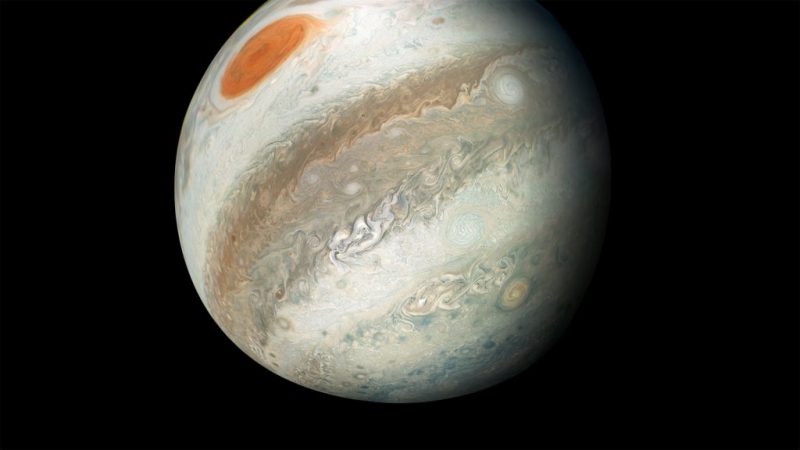Members of NASA’s Juno mission team, some of the world’s leading observers of Jupiter, and citizen scientists from across the globe are attending a workshop ‘New Views of Jupiter: Pro-Am Collaborations during and beyond the NASA Juno Mission’ at the Royal Astronomical Society in London on 10-11 May.
JunoCam images presented at the meeting by citizen scientists Gerald Eichstädt and Seán Doran include an animation showing the evolution of swirling features in the giant planet’s atmosphere and a composite image of Jupiter’s cloud tops.

Gerald Eichstädt, a mathematician working as a software professional, has taken two images from JunoCam and reprojected them to the same vantage point to enable a direct comparison between the images and show the subtle motions within the atmosphere. By modelling the movement of individual pixels in the images, he has created an animation that extrapolates the swirling evolution of the vortices in the atmosphere.
Eichstädt explains: “This animation represents a ‘feasibility test’. Building on this initial work, we can add in more variables that will give us a more detailed description and physical understanding of Jupiter’s atmosphere.”
Seán Doran, in collaboration with Eichstädt, has created a new composite image of Jupiter as seen by Juno as it swung away from Jupiter’s south pole on 1st April 2018. Because Jupiter was larger than JunoCam’s field of view when the main portion of the image was taken, Eichstädt rendered four other images to the same viewing geometry to reconstruct a mosaic of the whole planet. Doran then processed the composite image to balance and blend the overlapping components, sharpen the contrast, and fill gaps.
“It’s something of a labour of love that requires plenty of patience,” says Doran. “Energetic particles impact the CCD and produce bright specks. Once I’d finished the processing, I needed to go through and repair a couple hundred of these bright pixels.”
Leigh Fletcher of the University of Leicester, who has co-organised the workshop with the support of Europlanet 2020 Research Infrastructure, says: “The contribution of the Earth-based support campaign to the Juno mission, both professional and amateur, has proven to be invaluable in filling the spatial, temporal, and spectral gaps in Juno’s capabilities. Now two years into the mission, we’ve seen some tremendous new science emerging from this collaboration, and breath-taking imagery of Jupiter’s complex atmosphere that would not have been possible without the talented army of citizen scientists that have been working alongside the JunoCam team every step of the way.”
John Rogers of the British Astronomical Association, who co-organised the workshop says: “Many of these people have known each other for years by email addresses and social media alone, so to have them all in one place will be an incredibly special opportunity, fostering new collaborations and cementing existing friendships.”
Further information
The workshop ‘New Views of Jupiter: Pro-Am Collaborations during and beyond the NASA Juno Mission’ builds on a 2016 workshop, ‘Juno Ground-Based Support from Amateurs: Science and Public Impact’, hosted by the Observatoire de la Côte d’Azur. Both workshops have been supported by Europlanet 2020 RI through the European Union’s Horizon 2020 research and innovation programme under grant agreement No 654208.
NASA’s Jet Propulsion Laboratory, Pasadena, California, manages the Juno mission for the principal investigator, Scott Bolton, of the Southwest Research Institute in San Antonio. Juno is part of NASA’s New Frontiers Program, which is managed at NASA’s Marshall Space Flight Center in Huntsville, Alabama, for NASA’s Science Mission Directorate. The Italian Space Agency (ASI), contributed two instruments, a Ka-band frequency translator (KaT) and the Jovian Infrared Auroral Mapper (JIRAM). Lockheed Martin Space, Denver, built the spacecraft.
The public can follow the mission on Twitter at:
About Europlanet
Since 2005, Europlanet has provided Europe’s planetary science community with a platform to exchange ideas and personnel, share research tools, data and facilities, define key science goals for the future, and engage stakeholders, policy makers and European citizens with planetary science.
The Europlanet 2020 Research Infrastructure (RI) has received funding from the European Union’s Horizon 2020 research and innovation programme under grant agreement No 654208 to provide access to state-of-the-art research facilities across the European Research Area and a mechanism to coordinate Europe’s planetary science community. The project builds on a €2 million Framework 6 Coordination Action and €6 million Framework 7 Research Infrastructure funded by the European Commission.
Europlanet project website: www.europlanet-2020-ri.eu
Europlanet outreach website: www.europlanet-eu.org
Follow on Twitter via @europlanetmedia
About the Royal Astronomical Society
The Royal Astronomical Society (RAS), founded in 1820, encourages and promotes the study of astronomy, solar-system science, geophysics and closely related branches of science. The RAS organizes scientific meetings, publishes international research and review journals, recognizes outstanding achievements by the award of medals and prizes, maintains an extensive library, supports education through grants and outreach activities and represents UK astronomy nationally and internationally. Its more than 4,000 members (Fellows), a third based overseas, include scientific researchers in universities, observatories and laboratories as well as historians of astronomy and others.

 Subscribe to Physics & Astronomy's posts
Subscribe to Physics & Astronomy's posts
Recent Comments